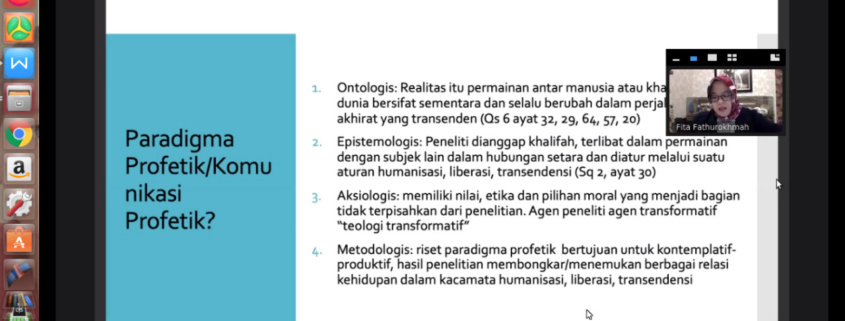New Perspectives in Prophetic Communication: Defending the Vulnerable
Recently, there has been criticism on the study of Islamic communication. Islamic communication is considered stagnant. How come. So far, the study of Islamic communication has not moved on to discussing the principles of communication in the Koran. Like qaulan syadiidan and baliigha. In fact, the communication dimension in the Quran is more than that.
Holy Rafika Dhona, Communication Lecturer at UII, said this in an online review of his book entitled Prophetic Communication, ‘Islamic Prophetic Perspectives’ in Communication on Sunday (17/1) online. The KBM Alumni Forum (Cultural and Media Studies) dissected Holy Rafika’s book by inviting two dissectors. First, Fita Fathurokhmah, Lecturer in Communication and Islamic Broadcasting from UIN Syarif Hidayatullah, Jakarta. Second, M. Heychael, Lecturer in Communication at Multimedia Nusantara University.
“Islamic communication stagnates, only to recognize whether this is in qoulan balighan, qaulan syadiidan, etc. But, when there is mustad’afin, why is it not discussed?” said Holy Rafika, author of the book published at the end of 2020. According to Holy, the book, published by UII Press, tries to push the idea of Islam that gives mercy to the universe even for those who are oppressed.
Holy emphasized the assumption, “There are people who are oppressed, you know. How can you just leave it. Islam is not what it should be. Islam discusses the principle of justice,” Holy continued.
What is the relationship between justice and the oppressed in Prophetic Communication? According to Holy, seeing the phenomenon of oppression with the value of justice is very easy. Holy emphasized that from an Islamic perspective. Islam has the concept that people who are oppressed indicate that they do not get justice. According to him, Islam exists to defend the weak so that justice can be upheld. “People who are oppressed are people who do not get justice. So Islam is here to defend those who are weak, in order to get justice,” Holy explained.
Fita Fathurokhmah, on the other hand, gave notes on the publication of this book. He gave input so that this book should be prepared more practically so that “My input, Mas Holy, can write the next book more on praxis. This will sell for sure. How is Prophetic Communication from the intrappersonal level, from the interpersonal level, groups, masses, the public, to the level of media and organizations, “suggested Fita.
In addition, Fita also criticized why this book did not discuss the conceptualization of her knowledge building about what epistemology is, what axiology, and what is epistemology.
Holy points out that the issue of conceptualization of knowledge has been discussed by previous authors, for example Prof. Iswandi and Heddy Ahimsa. Prof. Heddy Shri Ahimsa and Iswandi Syahputra have written their emphasis on the conceptualization of knowledge and others. There are talks about ontology, axiology, and prophetic epistemology. “If Prof Iswandi and Ahimsa it mustad’afin (defending the weak)–is missing,” he said. Here Holy wants to complete the study of rhophetic communication from a perspective that has been lacking so far, he patched another section.
“If you look at Pak Ahimsa’s version, there will be a debate about knowledge or not. But, in my opinion, knowledge must be rahmatan lil alamin,” he added.



